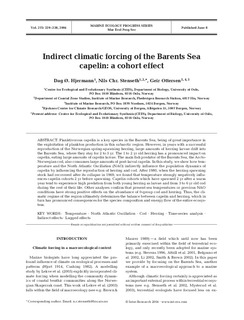| dc.contributor.author | Hjermann, Dag Ø. | |
| dc.contributor.author | Stenseth, Nils Christian | |
| dc.contributor.author | Ottersen, Geir | |
| dc.date.accessioned | 2010-11-30T14:52:41Z | |
| dc.date.available | 2010-11-30T14:52:41Z | |
| dc.date.issued | 2004-06-08 | |
| dc.identifier.issn | 0171-8630 | |
| dc.identifier.issn | 1616-1599 | |
| dc.identifier.uri | http://hdl.handle.net/11250/108890 | |
| dc.description | Journal homepage: http://www.int-res.com/journals/meps/ | en_US |
| dc.description.abstract | Planktivorous capelin is a key species in the Barents Sea, being of great importance in the exploitation of plankton production in this subarctic region. However, in years with a successful reproduction of the Norwegian spring-spawning herring, large amounts of herring larvae drift into
the Barents Sea, where they stay for 2 to 3 yr. The 1 to 2 yr old herring has a ronounced impact on capelin, eating large amounts of capelin larvae. The main fish predator of the Barents Sea, the Arcto- Norwegian cod, also consumes large amounts of post-larval capelin. In this study, we show how temperature and the North Atlantic Oscillation (NAO) indirectly influence the population dynamics of capelin by influencing the reproduction of herring and cod. After 1980, when the herring spawning stock had recovered after its collapse in 1969, we found that temperature strongly negatively influences capelin cohorts 2 yr before spawning. Capelin cohorts which have spawned 2 yr after a warm year tend to experience high predation from both young herring as larvae and from 3 to 6 yr old cod during the rest of their life. Other analyses confirm that present sea temperatures or previous NAO conditions have strong positive effects on the abundance of 0-group cod and herring. Thus, the climatic regime of the region ultimately determines the balance between capelin and herring, which in turn has pronounced consequences for the species composition and energy flow of the entire ecosystem. | en_US |
| dc.language.iso | eng | en_US |
| dc.publisher | Inter Research | en_US |
| dc.subject | temperature | en_US |
| dc.subject | temperatur | en_US |
| dc.subject | cod | en_US |
| dc.subject | torsk | en_US |
| dc.subject | herring | en_US |
| dc.subject | sild | en_US |
| dc.subject | capelin | en_US |
| dc.subject | lodde | en_US |
| dc.subject | Barents Sea | en_US |
| dc.subject | Barentshavet | en_US |
| dc.title | Indirect climatic forcing of the Barents Sea capelin: a cohort effect | en_US |
| dc.type | Journal article | en_US |
| dc.type | Peer reviewed | en_US |
| dc.subject.nsi | VDP::Agriculture and fishery disciplines: 900::Agriculture disciplines: 910::Livestock breeding, rearing, reproduction: 912 | en_US |
| dc.subject.nsi | VDP::Mathematics and natural science: 400::Zoology and botany: 480::Ecology: 488 | en_US |
| dc.subject.nsi | VDP::Mathematics and natural science: 400::Zoology and botany: 480::Marine biology: 497 | en_US |
| dc.source.pagenumber | 229-238 | en_US |
| dc.source.volume | 273 | |
| dc.source.journal | Marine Ecology Progress Series | |
| dc.identifier.doi | http://dx.doi.org/10.3354/meps273229 | |
